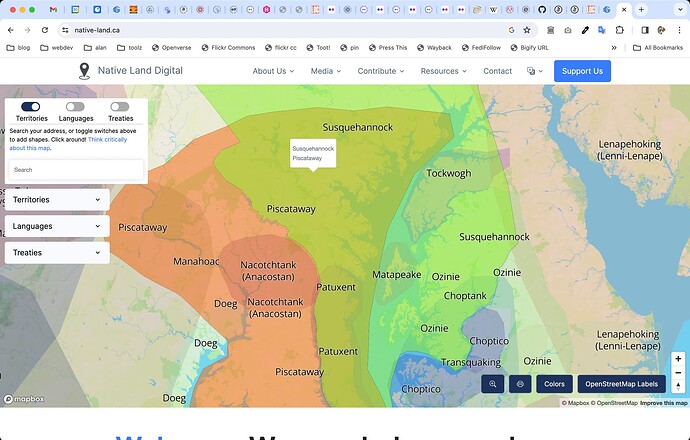Many weeks after the OEGlobal 2023 conference (see our OEG Live recap) I found this post that did not gather any responses.
Including me.
I was reminded because I had thought about it, I found a few open browser tabs that reminded me to come back.
My birthplace and childhood was on the east coast of the US, just outside of Baltimore, Maryland. Our community name was Lochearn a name I never gave much thought to. And I did not locate any info on where this came from, but given a Scottish sound to it, my best guess is for the lake in Scotland.
I cannot remember anything in school where we learned of the people that lived here before being “discovered” by Europeans. We probably got the heroic feats of Columbus, Pilgrims et al, that there was some peaceful welcome and exchanges in the 1600s, the quaint Thanksgiving story. But no recognition that indigenous people lived and thrived here for thousands of years.
I found some info in a great little site Maryland History by the Object for an entry connected to a Susquehannock pipe artifact.
It’s not surprising as a place for settling given proximity to fish and seafood in the nearby Chesapeake Bay and its tributaries, and forested land likely full of game. I did my map exploration with Native Land where now I finally know that these were the lands of the Susquehannock and the Piscataway people.
From the links in Native Land I learn that the Susquehannock people called themselves Conestoga, and more from the Conestoga-Susquehannock web site:
We, the Conestoga-Susquehannock, are the indigenous people of the Susquehanna river, a 444-mile long river that flows from what is now New York to Maryland, emptying into the Chesapeake bay. Our tribe was once a powerful coalition of palisaded villages and farms along the Susquehanna, where we practiced agriculture, foraged for oysters, and created our signature pottery and trade beads.
Our people are called Conestoga in our own language, which means the people of the upright ridge pole, and refers to our building practices. Susquehannock is how many of our historic neighbors referred to us, and is the most widely recognized name for our tribe.
And the language of Piscataway people is Conoy so similarly they refer themselves as Piscataway-Conoy where I find an interesting tag line “We are The People Where the Rivers Blend” referencing I am thinking as a metaphor for the rivers that join together in a network intimately to enter the Chesapeake Bay, itself a tributary to the Atlantic Ocean.
I can infer much has changed for recognizing the first people if this region, just be doing a web search on land acknowledgement baltimore where all the places I knew of Johns Hopkins University, University of Maryland Baltimore County, the Walters Art Gallery, Towson University, and a whole long list of organizations, schools and individuals publish land acknowledgments on their web sites .
It’s changed much.
But another memory of who lived there before was a neighborhood story. My memory of my childhood home was about the dense trees in areas, suggestion at one time it was widely forested. Just a block up the road was a wooded lot that unlike most other places, had no house.
The story amongst the kids was if you went on that lot, you could find the graves of three former slaves who fought and died in the Civil War. One supposedly had a grave marker. I actually never saw it myself, maybe I had fear of the dead or trespassing. It makes sense as some research I did suggest this area at one time was a plantation. This feeling of a different time, place, society than my tranquil childhood always stayed with me.
A very odd thing was that the last time I drove through my old neighborhood, maybe in 2011, there was a house built on that lot! I had always thought one could not build homes on a burial spot, so my hunch is that there was an exhumation? My research here never got far, I think I emailed a local historical society, and would have thought some info on this would have been in a building permit. Maybe that’s research for another day.
All is a reminder that lands always have many more stories than we may know, but we should always seek to know as much as we can.
I hope someone else might find this topic, and braid in their own land story.
